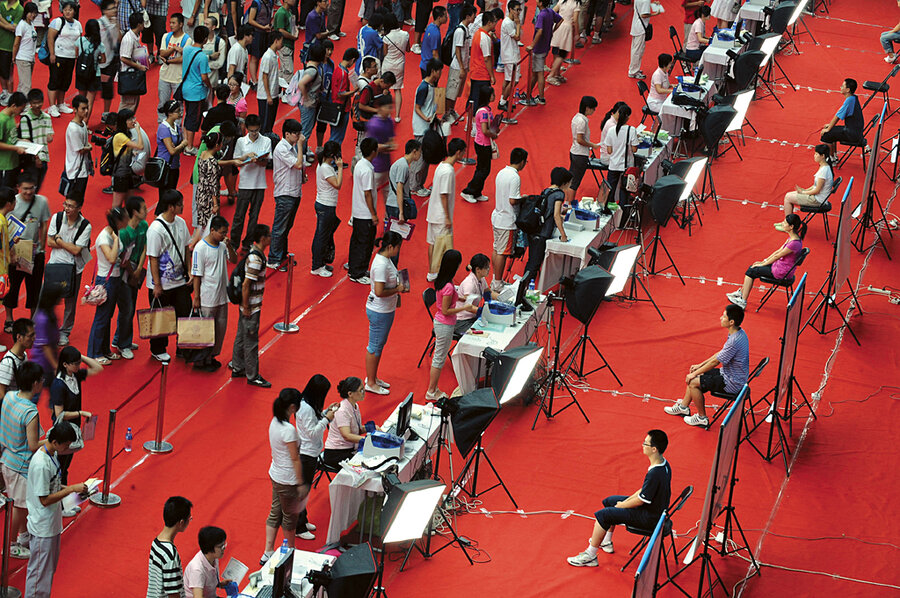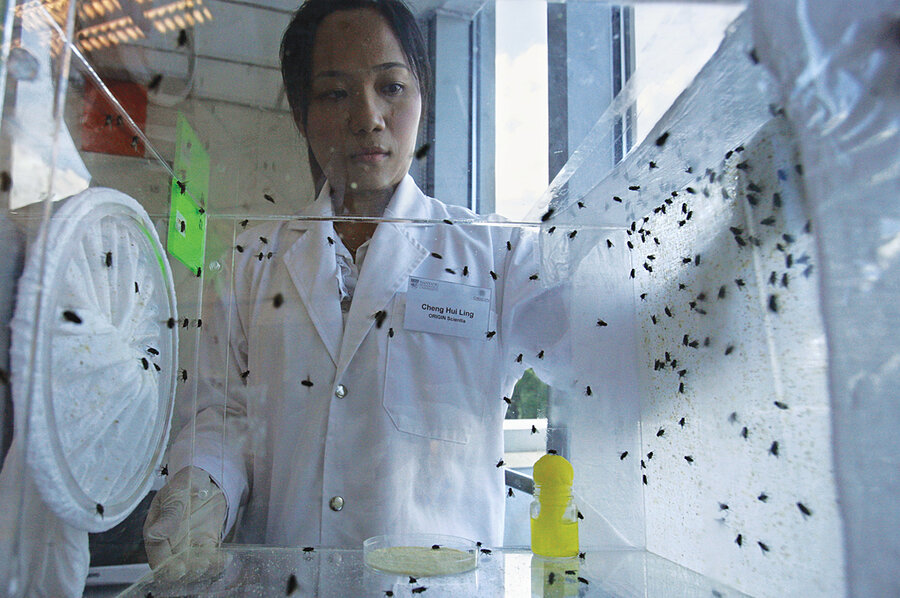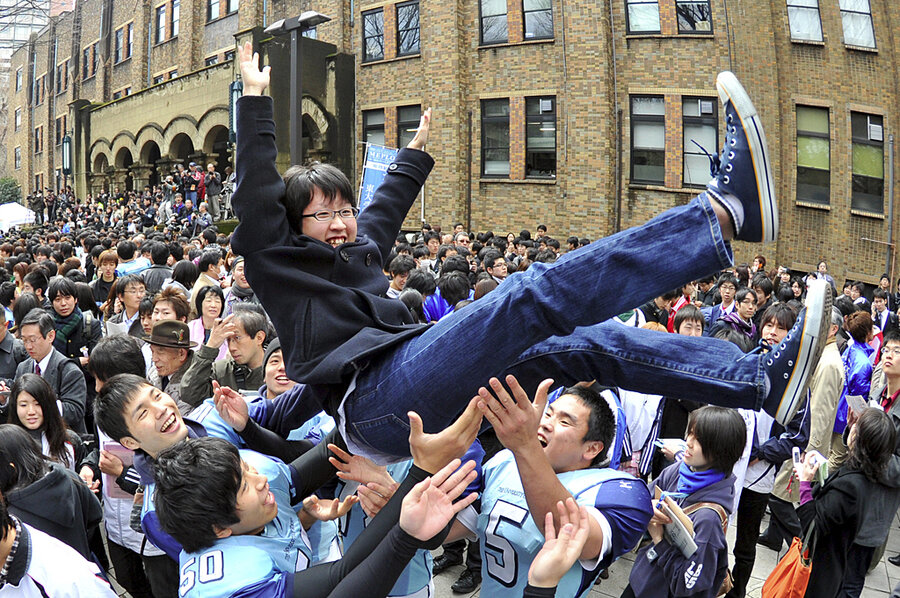US college degrees: Still the best among world's top universities?
Loading...
| New York
Ross Forman is one of American higher education's best and brightest. He may also be a canary in its coal mine.
Three years ago, he was looking for a university teaching job. He had stellar credentials – an undergraduate degree in history and literature from Harvard and a Stanford doctorate in comparative literature; he'd published in academic journals, coedited an anthology, and organized conferences.
A temporary teaching job in the English department at Skidmore College in Saratoga Springs, N.Y., was coming to an end, and he was looking to take the next step in his professorial journey. He sent out applications "mainly in the US," he says, but it was two applications that he sent farther afield that yielded the results: "I got both jobs in Asia: one in Hong Kong and one in Singapore."
Professor Forman is among a growing number of top-notch American academics teaching at the National University of Singapore (NUS) and other institutions in Asia and the Middle East, part of a trend that is helping Asian universities rise in international university rankings and fueling a crisis of confidence in American higher education.
Since World War II, US higher education has been the gold standard. But challenged by increasing foreign competition, rising tuition costs, government cutbacks, flagging graduation rates, and questions about the very quality of the education being delivered, US dominance in academic and research power is now under threat.
The warnings are stark: The US had better focus on its higher education or it is going to lose its technological and scientific edge and risk its economic future. For optimists, every negative news story is a spur to educational reform. For pessimists, each negative report signals the fall of the US in a global marketplace that increasingly prizes knowledge.
"The quality of the US's higher education system has historically been a powerful magnet," says Irwin Feller, who headed the Institute for Policy Research and Evaluation at Pennsylvania State University for 24 years and has served on a number of national committees on education policy. "We have been that sucking sound that has attracted the best and the brightest from around the world."
Growing foreign enrollment would seem to indicate that the US remains the destination of choice. The country has a rich infrastructure of 4,500 public and private postsecondary institutions with a high regard for academic freedom. They range from research universities offering postgraduate degrees to a network of two-year community colleges. Add to this technical and vocational colleges, four-year teaching schools committed to liberal arts, as well as new for-profit institutions, and the US offers the world's most variegated tapestry of higher education.
This variety is a chief attraction for foreign students. Even when their numbers fell in the four years following 9/11 – due to visa restrictions and global uncertainty – the largest year-to-year dip was only 2.4 percent. And foreign enrollment since has risen steadily to more than 670,000 in 2008-09 – more than 20 percent higher than 2000-01.
Even though the economic downturn is expected to affect foreign enrollment in September, international applications to graduate programs are up by 7 percent, says Peggy Blumenthal, vice president for educational services at the Institute of International Education (IIE) in New York.
International students may account for less than 4 percent of all enrollment, but their contribution to the US is disproportionately large. In 2009-10 they contributed $18 billion to the economy, according to estimates by the National Association of International Educators. That's the equivalent of 60 percent of US Department of Education spending on higher education in 2008, and a little more than it spent on student financial aid.
More significant still is foreign students' contribution to technological innovation and sciences: Close to 70 percent of all engineering PhDs granted in 2006 went to foreign-born students, as did more than half the doctoral degrees in the physical sciences, reports the National Science Foundation.
This means that most of the brainy heads in educational institutions bent over lab equipment, designing complex computer programs, or teaching undergraduates came to the US from abroad.
Nor does their impact end when they don cap and gown: Foreign-born entrepreneurs founded or cofounded more than half the engineering and technology companies that sprouted in Silicon Valley between 1995 and 2005, according to a Duke University report. Nationwide, they were sole founders or key partners in a quarter of these kinds of companies, producing $52 billion in sales and employing 450,000 workers in 2005.
As billions of dollars are invested in Asia and the Middle East to create world-class seats of learning and stanch the brain drain, there is a conscious effort to emulate the US model.
But imitation, some worry, may be the direst form of flattery.
That's why the likes of Professor Forman moving overseas causes hand-wringing.
Indeed, many of the world's best students increasingly have the option of getting a top-notch education closer to home by enrolling in such institutions as China's Tsinghua University in Beijing, the Indian Institute of Technology in Chennai (Madras), or the University of Tokyo. They can also choose from American-style institutions. As in Singapore, South Korea's Seoul National University and Saudi Arabia's King Abdullah University of Science and Technology (KAUST) – two prominent examples – have US-trained PhDs in their administrations, excel in the sciences, nurture the humanities, and actively recruit American and American-trained faculty.
But is this a threat?
In his book "The Great Brain Race," Ben Wildavsky writes with italic emphasis: "Increasing knowledge is not a zero-sum game. Intellectual gains by one country often benefit others." Indeed, as Yale President Richard Levin told the Royal Society in London in February, the more educated minds there are addressing the shortage of water, the persistence of poverty, the proliferation of nuclear weapons, and other pressing problems, the better off the world will be.
Ms. Blumenthal of IIE agrees, adding that thanks to economic development in Asia and elsewhere, there will be plenty of students to go around.
Demographic data may not paint the whole picture, however.
"I don't think the numbers [of foreign students] have gone down substantially," says Robert Berdahl, head of the Association of American Universities, a group of 63 top US and Canadian research universities. "But the fact is – and this was flat-out stated to me by a leading educator in China – 'You used to get our best students; we now keep our best students.' "
retaining dominance in global academic rankings, many experts warn, will provide little solace if US higher education is unaffordable. Already US graduation rates have fallen from second-highest in the world in 1995 to 14th in 2007, according to the Organization for Economic Cooperation and Development (OECD). And recent census results show that only in two states do young adults with college degrees outnumber those without.
"Pretend there was no foreign competition," Mr. Feller suggests. "If you instead look at higher education in the United States in terms of the US's objectives, the US population, and what higher education means for social mobility, diversity, and quality of life, it is scary."
He and others point to the rising cost of tuition.
"We are caught in a price spiral that is a good 30 years old now," says Kevin Carey, policy director at the Education Sector, a nonpartisan education policy think tank in Washington. US tuition costs outstrip by a wide margin those in Western Europe, Japan, Australia, and New Zealand, according to recent OECD figures. And while tuition rates for Singapore's prestigious NUS are as high as those at the best Ivy League schools, students have access to grants of up to 80 percent of the cost. KAUST in Saudi Arabia offers students free tuition, housing, medical care, and travel.
"I think it's important to define accessibility properly," says Mr. Carey, who nonetheless believes anyone bent on going to college in the US can.
This is where the rich tapestry of educational choices comes in: Tuitions at four-year private US institutions may average $26,273, but public colleges and universities charge in-state students an average of $7,020. At community colleges, it is $2,500.
But tuition is not the whole story. Add room and board, transportation, books, fees, and supplies, and a year at community college can cost $14,000.
"Students try to work while going to college or they try to go part time to spread it out," Carey says. "And working and part-time attendance are high risk factors for not finishing a degree."
To reverse this trend, President Obama increased federal funding for Pell Grants to a maximum of $5,550 per recipient. While it's welcome, many fear it is but a drop in the bucket. Students are having to borrow more than ever, according to Carey, whose think tank tracks growing loan default rates.
This has implications for society as a whole because there is a strong correlation between people's ability to get a postsecondary education and the wages they earn. Even though the federal government says that eight of the 10 fastest-growing US job categories don't require a bachelor's degree, the "college wage premium" – the difference in average salaries of a college and a high school graduate – is 70 percent. That makes access to higher education "the major reason for the widening of income distribution," says Tony Carnevale of the Georgetown University Center on Education and the Workforce. "In a sense, this is a social policy question. It hasn't been widely recognized as such, but it really is. You've got the segregation of kids from lower-income families, working-class families, minority kids in the two-year system getting stronger every year."
The economy, too, plays a part in the educational deficit. At least 39 states have cut assistance to public colleges and universities, and private institutions have seen returns on endowments fall 19 percent on average, the worst return since 1974. Across the country, many institutions have frozen salaries, imposed furloughs, trimmed campus services, and, in some cases, raised tuitions. These kinds of measures sent students into the streets in California earlier this year when they learned of a 32 percent undergraduate tuition hike in the University of California system. These kinds of measures also make top faculty look more keenly at offers from institutions abroad, which lure them with new labs, light teaching loads, and steady salaries.
And as federal stimulus money runs out and the recession lingers, administrators are scouring operational budgets, X-Acto knives in hand. While it makes sense to shut down programs with meager enrollment, it seems suicidal for liberal arts colleges to contemplate axing philosophy departments or for universities to consider boarding up the English, economics, computer sciences, or foreign language departments. Yet all of these and more are on the chopping block.
This worries even optimists like Richard Ekman, head of the Council of Independent Colleges, which works with more than 500 independent liberal arts colleges. He dismisses dire predictions about the future of liberal arts in an increasingly job-driven climate.
"But if this recession lasts a long time, it will be very hard for the less wealthy institutions to persist," he says. "I also worry that the wealthy institutions, who have had to take in their belts a lot this year ... may be overreacting and doing things they ultimately will regret when times return to some semblance of normality a few years down the road."
He points to the recommendation of a Harvard task force that the university libraries' priority should be access to scholarly material rather than always acquiring it. "You wonder if you give up comprehensive collecting and you happen to be the library of record in so many specialized fields," says Mr. Ekman, "how you ever recover that ground."
Research is also at risk. The economic downturn has forced companies to curtail spending on projects that don't directly affect their bottom line. And while the Obama administration supports research through the National Security Agency, the National Science Foundation, and the Department of Energy, this involves only select fields, leaving other basic research that universities have historically provided in peril. "It has always been the case," says Norman Augustine, retired chairman and CEO of Lockheed Martin, "that the federal government should have a major role in research. Truly basic research that benefits society as a whole should be funded by the government."
As parents sit on folding chairs this spring to watch their sons and daughters, caps askew and gowns a-blowing, reach for their diplomas, they may not want to ask what it is exactly their tuition dollars bought. Because as efficient as the country is at assessing students when they apply to college, there's no coordinated assessment of what knowledge and skills they have acquired by the time they leave.
As a result, the government and employers are increasingly concerned about the education American graduates receive.
Asked by Congress in 2005 what it would take "to ensure the preeminence of America's scientific and technological enterprise," a National Academies of Science committee warned that South Korea, France, China, and Singapore were generating proportionately more students majoring in natural science and engineering. But the committee had no qualms about the quality of education the US was providing.
"We're still the gold standard without question," says Mr. Augustine, who chaired the committee, "but the stature and ability of our higher education system to produce qualified people and produce knowledge is in danger. Whereas five years ago I would have said we don't have to worry about that for the next 30 years, I think today we need to worry a lot. Things can happen quickly."
Employers surveyed last year by the Association of American Colleges and Universities have their doubts, too. Most of the 320 employers with 25 or more employees said they believe workplace complexities would force them to hire only people with four-year degrees – but only 28 percent thought four-year institutions are doing a good job preparing students.
Above all, they said, they want people who can communicate well orally and in writing, and, second, people who can think critically and analytically.
Against this backdrop, a finding of a 2007 survey by the American Institutes of Research is particularly chilling: "[M]ore than 50 percent of students at 4-year colleges do not score at the proficient level of literacy. This means that they lack the skills to perform complex literacy tasks, such as comparing credit card offers with different interest rates or summarizing the arguments of newspaper editorials." Such results don't bode well for Americans' performance in the global economy – which is increasingly knowledge-based – nor for their performance as citizens of a democracy or their ability to remain at the cutting edge of technology and innovation.
"We have shifted the cost of education from a public good to a private good over the last 20-plus years," says Feller. "We have begun to see higher education as something that benefits individuals – which is true – but we've lost sight of the societal benefit not only of having a population that is better trained and better educated, but also of providing opportunity" so that 18-year-olds don't feel "dead-ended" but know they can use education to retool and create a better life.
Fixing the problems in higher education is going to require taxpayer support, say experts. And that, in turn, requires that the public understand the true costs of what is a very labor-intensive field.
"Tuition in most cases is little more than half the cost," Mr. Carnevale says. The rest comes from state and federal government or the institution and alumni.
To gain public support, institutions will have to provide evidence that education is a worthwhile investment. And, uneasy about the government imposing standardized goals – as President Bush's secretary of Education Margaret Spellings proposed in 2006 – institutions nevertheless appear poised to assess student learning. But they want faculty – not an outside agency – to choose the methods.
Evidence of this shift can be found in the new popularity of capstone projects and academic portfolios as a way to gauge students' skills and knowledge. Another favored new tool is the Collegiate Learning Assessment, administered intermittently over the course of a student's enrollment to gauge progress in such areas as critical thinking, communication, problem solving, and reasoning.
The optimists hope that such changes are part of a revolution: that colleges and universities will become more transparent, politicians will recognize higher education as a pressing social and economic issue, and taxpayers will understand that supporting quality higher education benefits all.
Otherwise, pessimists worry, bright minds with shallow pockets will not get access to the education they need to develop into tomorrow's engineers, inventors, and entrepreneurs; the US will be wasting its most precious resource; and, as Carey puts it, "we will have nowhere to go but down."










